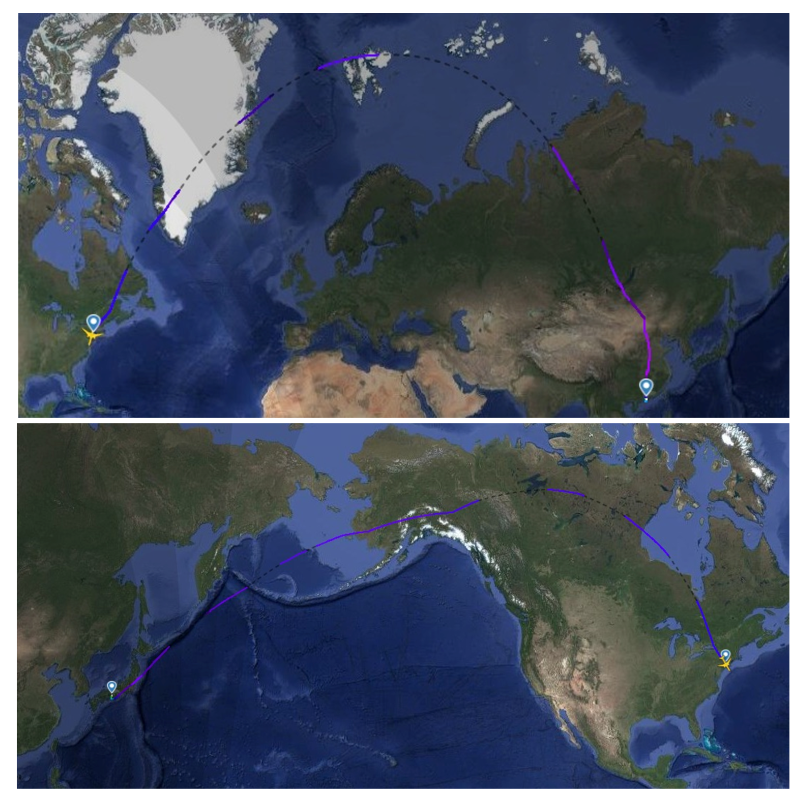Effects of Space Weather to Polar Flight Routes
Effects of Space Weather to Polar Flight Routes
CHONG Man-lok
January 2025
An episode of violent solar activities occurred in early to mid-October 2024. At that time, the aurora was observed in some mid-latitude regions such as Beijing, which was quite rare [1]. Behind this spectacular and stunning sight, the airlines had to assess the threats of solar activity to aviation safety, and make adjustments to some flight routes. Since the Earth is shaped like almost a sphere, the shortest route from New York to Hong Kong has to pass through the vicinity of the North Pole (Figure 1, top), rather than traversing the Pacific or Atlantic Ocean [2]. However, due to violent solar activities in October, flights had to be rerouted to avoid flying through regions near the North Pole. As a result, the flight route was lengthened and flights had to stop at Kansai Airport of Japan (Figure 1, bottom) for refuelling and change of flight crew to continue the flights. The total travelling time was significantly extended for about 6 hours. Apart from the extension of travelling time, how would space weather induce aviation hazards to the flights over polar regions?
When there is violent activity over the surface of the sun, the sun will eject a large amount of high-energy and magnetic field bearing matter into space, including protons and plasma. The propagation speed of the matter varies. If the matter successfully reaches the Earth's magnetic field, the protons only take 30 minutes to a few hours, whereas the plasma needs about 20 to 90 hours. The matter would be guided along the Earth’s magnetic field and penetrate into the atmosphere near the North and South Poles, so the polar regions are generally more directly affected by solar activities. For our Earth, high-energy protons will lead to solar radiation storms, and plasma will bring about geomagnetic storms. The aurora is a major visible phenomenon caused by geomagnetic storms. The aforementioned two space weather phenomena may occur at the same time, and both could last for hours to days.
According to the Space Weather Prediction Center of the United States, during the violent solar event in October, the solar radiation storm and geomagnetic storm levels reached S3 (Strong) and G4 (Severe) respectively (Level 5 is the most severe for both phenomena, refer to this link for space weather scales) [3]. During solar radiation storms, some high-energy particles will enter the atmosphere of polar regions. Passengers and crew flying at these high latitude areas would be exposed to higher risk of ionized radiation. Meanwhile, collision of high-energy particles within the atmosphere may create a layer of free electrons near the bottom of the ionosphere, which can absorb high frequency radio waves. This could impede or even block the communication of flights [4]. For geomagnetic storms, external energy would heat up the ionosphere and change its density. Uneven distribution of ionospheric density would affect the path of radio signals, disrupting the Global Navigation Satellite System and communication systems of aircraft [5].
Before the journey of flights across polar regions, airlines will have to refer to information and advisories issued by various space weather centres to ensure the safety of flights and passengers. Backup plans such as rerouting or suspending relevant flights would be formulated in case of space weather that may impact aviation safety.

Figure 1 The original (top) and rerouted (bottom) courses of flight from New York to Hong Kong (Source: Flightradar24).
References:
[1] Beijing Municipal Government: Rare Northern Lights Spotted Over Beijing.
[2] Cool Met Stuff: Great Circle (in Chinese only).
[3] Space Weather Prediction Center of the United States: Space Weather Highlights (07-13 Oct 2024).
[4] Space Weather Prediction Center of the United States: Solar Radiation Storm.
[5] Space Weather Prediction Center of the United States: Geomagnetic Storms.
[1] Beijing Municipal Government: Rare Northern Lights Spotted Over Beijing.
[2] Cool Met Stuff: Great Circle (in Chinese only).
[3] Space Weather Prediction Center of the United States: Space Weather Highlights (07-13 Oct 2024).
[4] Space Weather Prediction Center of the United States: Solar Radiation Storm.
[5] Space Weather Prediction Center of the United States: Geomagnetic Storms.